Related Research Articles

Simulated annealing (SA) is a probabilistic technique for approximating the global optimum of a given function. Specifically, it is a metaheuristic to approximate global optimization in a large search space for an optimization problem. It is often used when the search space is discrete. For problems where finding an approximate global optimum is more important than finding a precise local optimum in a fixed amount of time, simulated annealing may be preferable to exact algorithms such as gradient descent or branch and bound.
In computer science, local search is a heuristic method for solving computationally hard optimization problems. Local search can be used on problems that can be formulated as finding a solution maximizing a criterion among a number of candidate solutions. Local search algorithms move from solution to solution in the space of candidate solutions by applying local changes, until a solution deemed optimal is found or a time bound is elapsed.
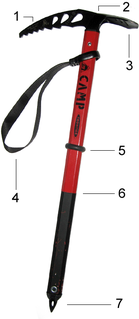
An ice axe is a multi-purpose hiking and climbing tool used by mountaineers in both the ascent and descent of routes that involve snow, ice, or frozen conditions. Its use depends on the terrain: in its simplest role it is used like a walking stick, with the mountaineer holding the head in the center of their uphill hand. On steep terrain it is swung by its handle and embedded in snow or ice for security and an aid to traction. It can also be buried pick down, the rope tied around the shaft to form a secure anchor on which to bring up a second climber, or buried vertically to form a stomp belay. The adze is used to cut footholds, as well as scoop out compacted snow to bury the axe as a belay anchor.
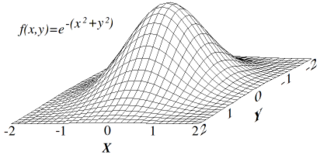
In numerical analysis, hill climbing is a mathematical optimization technique which belongs to the family of local search. It is an iterative algorithm that starts with an arbitrary solution to a problem, then attempts to find a better solution by making an incremental change to the solution. If the change produces a better solution, another incremental change is made to the new solution, and so on until no further improvements can be found.

A climbing specialist or climber, also known as a grimpeur, is a road bicycle racer who can ride especially well on highly inclined roads, such as those found among hills or mountains.

Hillclimbing is a branch of motorsport in which drivers compete against the clock to complete an uphill course.
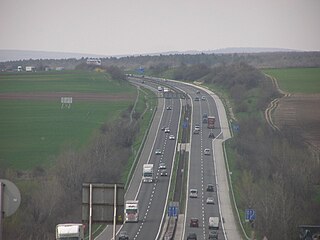
Climbing lanes or crawler lanes are a roadway lane design. They allow slower travel for large vehicles, such as large trucks or semi-trailer trucks, ascending a steep grade. Since climbing uphill is difficult for these vehicles, they can travel in the climbing lane without slowing traffic.
The Mendip Way is an 80-kilometre (50 mi) long-distance footpath across the Mendip Hills from Weston-super-Mare to Frome. It is divided into two sections.

Hill Climbing is a cycling event, as well as a basic skill of the sport. As events a hill climb may either be an individual time trial or make up part of a regular road race. A hill climb usually represents an event which gains altitude continuously, usually terminating at a summit. Occasionally featured in major professional races, such as the Tour de France, they are usually referred to as mountain time trials, and are not necessarily from the bottom to the top of a hill, as they can simply be a time trial over hilly terrain.
The Usk Valley Walk is a waymarked long distance footpath in south east Wales, from Caerleon to Brecon.
Evryali is a piece for solo piano composed by Iannis Xenakis in 1973. It is based on a technique Xenakis invented in early 1970s, called arborescences—proliferations of melodic lines created from a generative contour. The title refers to the name of one of the Gorgon sisters, and is also Greek for open sea.

Neemach Mata Temple is located on a hill on the banks of the Fateh Sagar Lake in the city of Udaipur, Rajasthan,India. This temple is located on a green hill in the Dewali area of Udaipur. It has both stairs and uphill slope walk way to climb, which is around 900 metres long. It enshrines the stone idol of Neemach Mata Devi. There is also an idol of Lord Ganesh and three west-facing lions of stone.
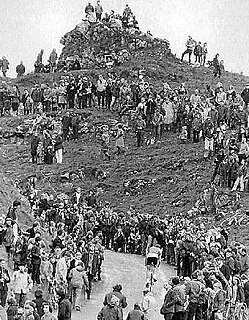
The British National Hill Climb Championship is a hill climbing competition held annually by Cycling Time Trials with the location varying year on year. The first edition was in 1944 and it has been won by some of the best all-round British cyclists, such as Brian Robinson, Paul Curran, Malcolm Elliot, Chris Boardman and Jeff Williams.

Wildebeest is a water coaster at Holiday World & Splashin' Safari in Santa Claus, Indiana, United States. It was designed and built beginning in 2009 by ProSlide Technology; it opened on May 7, 2010. Wildebeest is named after the African mammal, keeping with the water park's safari theme. When it was completed in 2010, Wildebeest held the record for the world's longest water coaster at 1,710 feet (520 m) long. It held that record until May 11, 2012, when Mammoth, Holiday World's second water coaster, took over the title at 1,763 feet (537 m) long. In 2010, Wildebeest was voted the world's "Best New Waterpark Ride" at the Golden Ticket Awards, which are presented annually by Amusement Today magazine. Wildebeest was also awarded the Golden Ticket Award for "Best Waterpark Ride" in 2010 and 2011.
Emily Caroline "Lily" Bristow was an English mountaineer who made numerous ascents in the Swiss Alps with Albert F. Mummery in the 1890s.
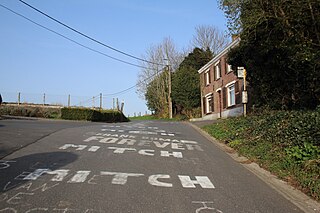
The Leberg is a hill and uphill street in Elst, part of the municipality of Brakel, in the Belgian province of East Flanders. Its top is at 99 m altitude, making it one of the highest hills of the Zwalm region, just north of the Flemish Ardennes. The road has an asphalt surface and links the valley town of Elst to the hilltop town of Zegelsem.
The Kruisberg, also known as Oude Kruisberg or Oude Kruisens, is a hill and road in the city of Ronse, in Flanders, Belgium. With its top at 122 m altitude, its is one of many hill formations in the Flemish Ardennes, in the south of East-Flanders. The road starts going gently uphill from the center of Ronse. The upper and steepest part of the climb consists of 450 m of cobbled surface.

Kortekeer is the name of an uphill road in the municipality of Maarkedal, in the Belgian province of East Flanders. With its top at 88 m, it is one of the many hills in the Flemish Ardennes. The road is narrow with steep bankings on either side with an asphalted surface. The steepest point is 17.1%. It was the epicenter of one of the most powerful earthquakes ever measured in Belgium, at 5.5 on the Richter scale in 1938.
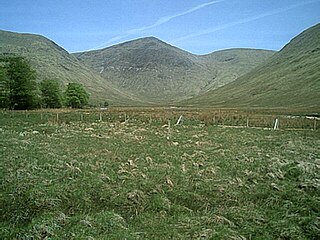
Creach Bheinn is a prominent mountain in the Morvern area in the west of Scotland. It is less steep and even less frequently climbed than its northern neighbour, Garbh Bheinn, but the views to the south and west to the islands are open and extensive.
Rathasena Mata Temple is located on a hill on Maruwas area in the city of Udaipur, Rajasthan. This temple is located on a green hill in the Maruwas, area of Udaipur. It has uphill slope walkway to climb. It enshrines the stone idol of Rathasan Mata.
References
- ↑ Russell, S.; Norvig, P. (2010). Artificial Intelligence: A Modern Approach (3rd ed.). Prentice Hall. ISBN 978-0136042594.